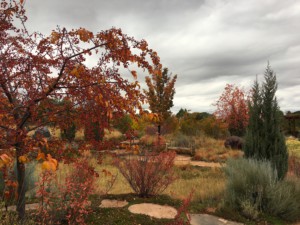November 2018
By Scott Canning, Horticulture and Special Projects Director

November is still a good time to plant or transplant deciduous trees and shrubs. It is getting too late to transplant conifers, because they continue to transpire (lose water from their needles) through the winter and suffer from the root-pruning that invariable accompanies transplanting. They can, however, still be planted out from containers, and you can even still plant balled and burlapped conifers, if they haven’t been dug recently and look robust. Deciduous trees and shrubs give you a longer window because they lose their leaves and transpire very little from their trunks and twigs. They will start to grow roots in the spring before they leaf out, to make up for roots lost when they are moved. I know, it is NOT a hard-and-fast rule, but if you think about water lost through needles throughout the winter versus water not lost by trees that drop their leaves, I hope it begins to make sense.
Protect your trees, especially young ones, by removing grass and weeds from their base where rodents might feed on young bark and wood in winter. Consider hardware cloth collars—they will protect young trees even if there is snow that might hide the enemy: Rodents don’t truly hibernate and love trench warfare in winter. Also consider propping any small weeping trees with some extra staking to avoid breakage in case of that rare, heavy wet snow.
Winterize your irrigation system if you haven’t already. Well-designed systems might have gravity drains; otherwise, you might need to use compressed air or have an irrigation contractor do it. The most vulnerable components are the hard plastic pipes and valves in outside valve boxes. Exposed backflow preventers are vulnerable, too. I know some folks who fill plastic bags with packing material (“peanuts” or fiberglass batting) and layer them into their valve boxes, but if we drop below zero, all bets are off!
In the flower garden it is time to dig and store dahlias, gladiolus and other tender bulbs you may have planted in spring. They can be stored in a box of barely damp material (crushed leaves, ambrosia or other wood shavings, or peat) in a cool but not freezing location. (I know; avoid using peat-its use is really not sustainable). It is also last-call for fall-planted spring-flowering bulbs. You might find great sales at the end of the season. Two of my go-to sources are Brent & Becky’s Bulbs and Van Engelen/Scheepers. Time, too, to start cleanup, but leave your self-sowers and ornamental grasses standing, as well as any plants that are forage for birds.
In the vegetable garden, sow a cover crop or a mix of cover crops as you empty the beds. And in a hopeful gesture at this time of year, besides planting bulbs, you can sow a bed of spinach for your earliest crop next year. And continue to compost, compost, and compost some more!


